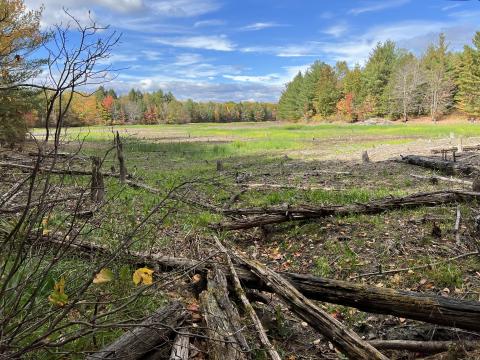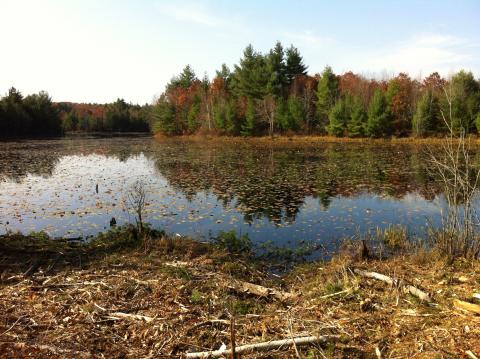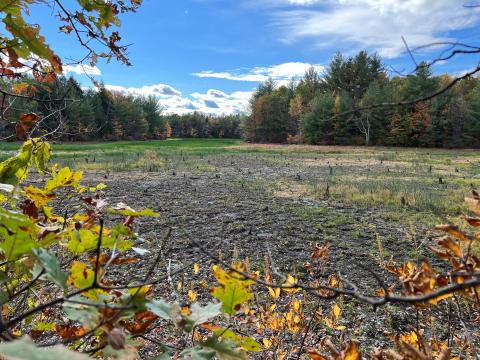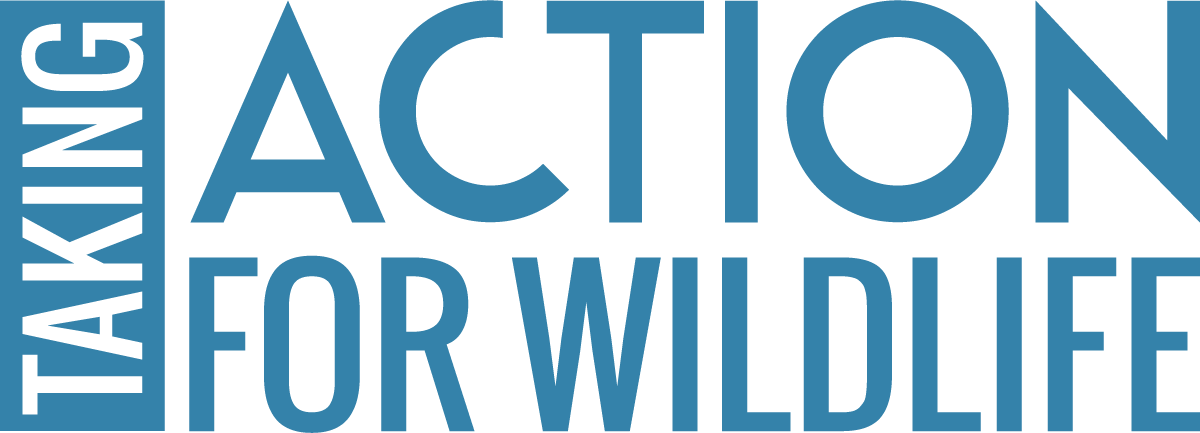Bye, Beavers!
I had heard the rumors, but I had to see it for myself. I pulled up to the trailhead at Southeast Land Trust’s Tucker and French Family Forest on a beautiful fall afternoon. The property, at nearly 600 acres, is located in Kingston, NH and has a beautiful trail network that winds through a mix of habitats – older forests, young forest patches, a mix of wetland types, and at the heart of it all, a large beaver pond called Mill Pond. I haven’t visited this property in quite some time, but I still remember one visit many years ago in the early summer. Mill Pond was absolutely covered with lily pads, and I had (by pure luck) timed my visit when both the lily pads and sweet pepperbush were in full bloom. It was beautiful and the smell was amazing. It’s an impressive pond to say the least.
Beyond its beauty, Mill Pond, like all beaver ponds, provides important habitat for a lot of different wildlife species. Beaver ponds, formed when beavers dam a waterway, provide habitat for fish, frogs, turtles, snakes, river otters, and many other aquatic species, but also enhance the surrounding habitat for terrestrial wildlife as well. These ponds often contain dead standing trees (also called snags), which create nesting habitat for blue herons, wood ducks, woodpeckers, and more. Despite their beauty and value to wildlife, beaver ponds are not permanent. Beavers primarily eat fresh leaves, bark, twigs, and stems of trees, and they preferentially eat hardwood tree species, especially aspen, alder, and birch. Over time, beavers will diminish the food supply available immediately around their pond, and the beavers will move on. Without regular maintenance by the beavers, the dams will degrade over time and can fail, and even an active beaver dams can fail after extreme weather events. When the dam is blown out, the pond will drain revealing all the rich mud and muck that was sitting at the bottom of the pond. While this may look unsightly at first, it’s all part of the natural life cycle of a beaver pond. This newly exposed soil will grow grasses, and eventually shrubs, and trees if beavers do not immediately rebuild the dam. This successional process creates new and diverse habitats for wildlife over time, and chances are the beaver will return eventually.

My first view of what had been Mill Pond, now a large, open, and grassy habitat.
I started along the Mill Pond Loop trail through the woods and when I got to the first outlook over the pond, I could see that the rumors were true. Mill Pond was gone! The dam had apparently blown out after sustained heavy rains back in early August. No lily pads, no water, just a large grassy area with patches of bare ground and just a small stream trickling through the middle. It was an impressive change in the landscape. I walked down to the edge of where the pond had been, I was surprised at how quickly grasses and other vegetation had grown into the flat expanse of mud and dirt with barely any remaining sign of lily pads. A lot of deer tracks crisscross the opening. I wonder what they thought of this pond-turned-field in their landscape.

A view of the beaver pond in 2012.

A very similar view in October 2021.
It’s amazing and lucky to be able to see the natural life cycle of a beaver pond unfold before us. Beavers have a large impact on the landscape, and in more developed areas, the flooding that results from beaver dams can damage human infrastructure. Most landowners aren’t willing or able to allow beavers to create large wetlands on their property. Conserved lands, like Tucker and French Family Forest, provide a place for beavers to do what beavers do without disruption. On this visit, I didn’t see any signs of beavers trying to repair the dam, though they are active elsewhere on the property. I’m looking forward to visiting the property into the future to watch what happens and how this amazing habitat changes over time.
2021 Fall Taking Action for Wildlife Newsletter



